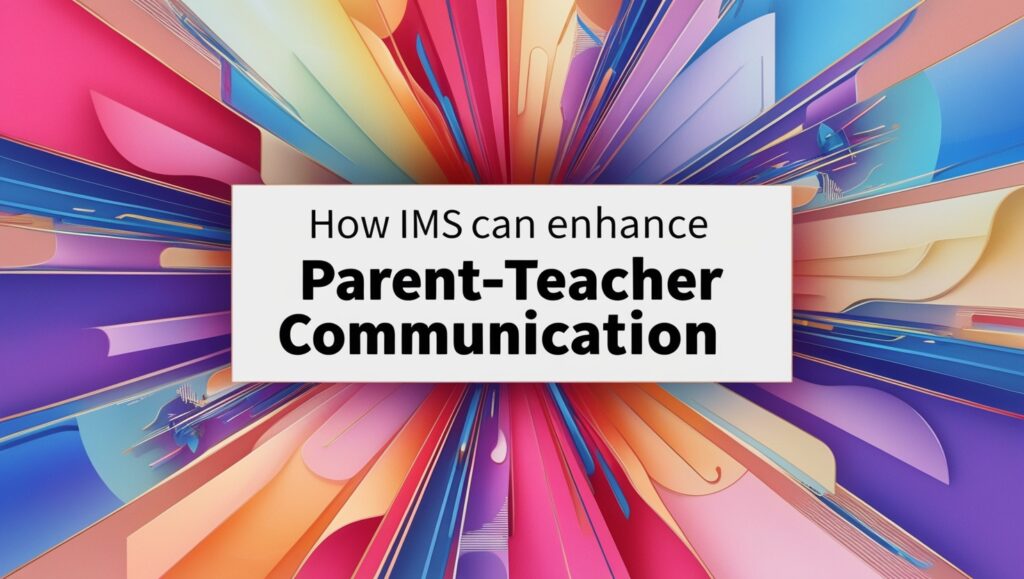How IMS Can Enhance Parent-Teacher Communication

Effective communication between parents and teachers is vital for a student’s academic success and overall well-being. Parents need to be informed about their child’s progress, school activities, and any concerns that may arise. Traditionally, parent-teacher communication has relied on phone calls, emails, and in-person meetings, which can be time-consuming and prone to miscommunication. However, with the advent of Institute Management Systems (IMS), schools can now offer a more streamlined and efficient way to connect parents and teachers. This article explores how an IMS can enhance parent-teacher communication and foster a more collaborative educational environment.
The Importance of Parent-Teacher Communication
Strong communication between parents and teachers has been shown to improve student performance, increase parental involvement, and create a supportive educational experience. When parents are actively engaged and informed, they can better support their children’s academic journey. Yet, without the right tools, maintaining effective communication can be a challenge for schools, especially those with large student populations.
An IMS provides a centralized platform that simplifies communication and ensures that all stakeholders—teachers, parents, and administrators—are on the same page. By using features such as parent-teacher portals, school messaging systems, and real-time updates, IMS transforms how schools manage communication.
Key Features of an IMS for Parent-Teacher Communication
1. Parent-Teacher Portal
One of the standout features of an IMS is the parent-teacher portal, a secure online space where parents can access important information about their child’s education. Through the portal, parents can view academic progress, attendance records, upcoming assignments, and school announcements. Teachers can also use the portal to share feedback, schedule meetings, and post updates about classroom activities.
This level of transparency keeps parents informed and engaged, reducing the need for frequent in-person meetings and making communication more convenient for busy families.
2. School Messaging System
A reliable school messaging system is another crucial component of an IMS. This feature enables real-time communication between teachers and parents through text messages, emails, or app notifications. Whether it’s sending reminders about parent-teacher conferences or notifying parents of an emergency, the school messaging system ensures that important information reaches parents instantly.
Teachers can also use the messaging system to share updates about student behavior, classroom performance, or any issues that need parental attention. This immediate and direct form of communication helps prevent misunderstandings and ensures that parents are well-informed.
3. Automated Notifications and Alerts
An IMS can automate routine notifications and alerts, saving time for both teachers and administrative staff. Parents can receive automated reminders about upcoming exams, fee payment deadlines, or school events. These notifications can be personalized and sent through multiple channels, such as SMS, email, or mobile app notifications.
Automating these reminders not only improves the efficiency of school operations but also ensures that parents never miss important updates, fostering a proactive approach to school communication.
4. Digital Progress Reports and Feedback
Gone are the days of waiting for parent-teacher meetings to receive updates on a child’s performance. An IMS allows teachers to upload digital progress reports and share feedback in real time. Parents can log in to the parent-teacher portal to view grades, teacher comments, and areas where their child may need additional support.
This feature empowers parents to stay involved in their child’s academic journey and take timely action when needed. It also allows teachers to provide detailed and constructive feedback, enhancing the overall communication process.
5. Event Scheduling and Meeting Management
Coordinating parent-teacher meetings can be a logistical nightmare, especially for large schools. An IMS simplifies this process by offering event scheduling tools that allow teachers to set up meetings, send invitations, and track RSVPs. Parents can choose convenient time slots, reducing scheduling conflicts and ensuring that meetings are productive.
Additionally, virtual meeting options integrated into the IMS platform make it easier for parents who may not be able to visit the school in person. This flexibility enhances communication and makes it accessible to all families, regardless of their schedules.
How IMS Improves School Communication as a Whole
Beyond enhancing parent-teacher interactions, an IMS plays a crucial role in improving overall school communication. By centralizing all communication channels, the system ensures that information flows smoothly between teachers, parents, students, and administrators. Important updates, such as school closures, policy changes, or extracurricular activities, can be broadcasted efficiently, reducing the risk of miscommunication.
Systems like Digital Class IMS exemplify how technology can transform school communication. With features like automated alerts, integrated messaging, and real-time updates, Digital Class IMS ensures that everyone stays informed and engaged. By providing a secure and user-friendly platform, it bridges the gap between parents and teachers, fostering a supportive and transparent educational environment.
Conclusion
An Institute Management System (IMS) is a powerful tool that can significantly enhance parent-teacher communication. With features like parent-teacher portals, school messaging systems, and automated notifications, IMS solutions make it easier for parents to stay informed and for teachers to provide timely updates. This improved communication fosters a collaborative environment where parents, teachers, and students can work together to achieve academic success.
By integrating a robust IMS like Digital Class, schools can streamline communication, increase parental involvement, and create a more cohesive and supportive community. As technology continues to evolve, investing in an IMS will remain a strategic move for schools aiming to improve communication and boost student outcomes.
